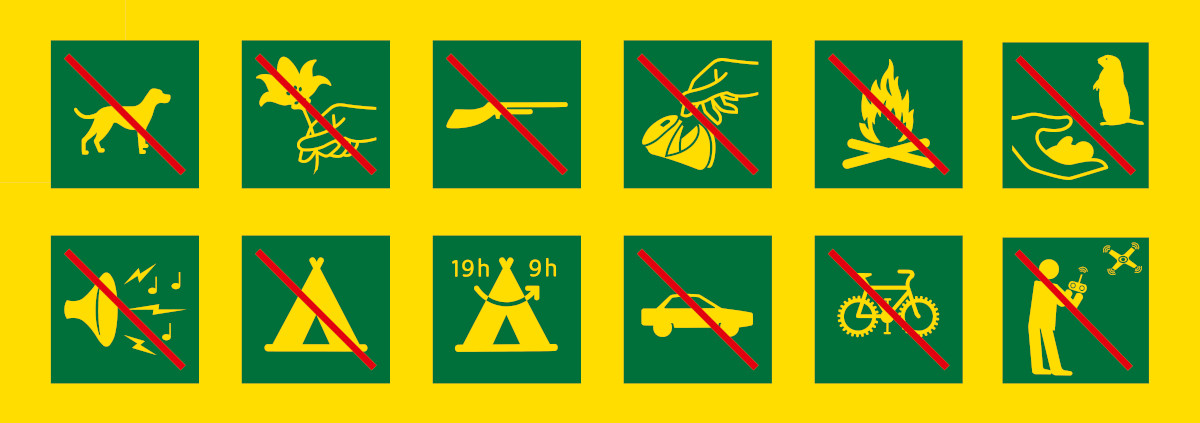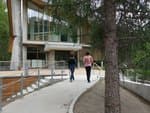Le refuge du Pelvoux
On the 8th August 1848, Pierre-Antoine Barnéoud took Victor Puiseux with him. After a night spent in "the fallen rock that served as a hut to the shepherd from Provence", alone, he climbed to the top of the Durand and then achieved the first ascension of the true peak of the Pelvoux.
20 points of interest
 Fauna
FaunaRoe Deer
Hidden in the larch forest, the Roe Deer sometimes shows its fine head at dawn or at dusk. Not always easy to see this discreet animal but a few tracks or droppings can give its presence away.: the heart shaped print of its delicate hooves, the trunks of shrubs nicked by young fallow deer rubbing new antlers there to remove the last shreds of velvet, Sometimes it is a deep sonorous and guttural bark that resonates in the woods.
 Fauna
FaunaEurasian Tree Creeper
The Eurasian Tree Creeper is a small, compact and agile bird. Its beak is long and curved and its tail is composed of stiff feathers. Its long claws have sharp nails. So many adaptations enabling it to explore the bark of the larch trees where it hunts for insects and other spiders which make up its diet all through the year.
 Fauna
FaunaWestern Bonelli’s Warbler
This common little sparrow is rarely seen but often heard. It interprets a brief song lasting just a few seconds, with around ten repetitive notes, which quickly become identifiable, rather haunting. The male sings almost throughout the year, from April to July, then only in the morning in July. After the storm when the trees are still dripping with rain, he starts singing immediately. At the end of August males et females leave for the African savannah forest regions, followed by that years young.
 Fauna
FaunaWhite Throated Dipper
Stocky, short tail, tapered beak, the White Throated Dipper is often perched in the middle of a torrent, on a boulder at water level. Recognizable by the white mark on its chin and chest and the rest of its red and slate grey plumage, this bird dives in the icy water looking for aquatic larvae which are the essential ingredient of its menu.
 Flora
FloraRhododendron
The rhododendron, shrub with brightly coloured carmine flowers, is often accompanied by blue berries, green alders and other small willows. It is characteristic of the combat zone. Situated between the edge of the forest and the last trees, this transitional space is particularly favoured by the Black Grouse to nest in and to feed quietly.
 Fauna
FaunaMay Fly
This beautiful insect flies right across the surface of the water to lay its eggs which transform in to aquatic larvae. They will continue to live for up to two years in the stream before metamorphosing into a perfect insect, the 'imago which is incapable of feeding itself, does not live for more than a few days but does breed.
 Fauna
FaunaSmall Tortoise Shell Butterfly
This animal, which is not at all like a reptile « with a shell », sports a rather flamboyant covering The top of its bright orange wings, incrusted with ebony and edged with blue lunules outlined in black, compose its decoration. Precocious, the Small Tortoishell is the first butterfly to visit the flowers which have only just come out from under the snow on the most well exposed slopes.
 Flora
FloraWhite Hellebore
The White Hellebore is a plant that seems almost completely white, but you can distinguish the green-white flowers as soon as you approach it. Its large wide alternating leaves along the stalk enabling you to distinguish it from the Gentian whose leaves are opposite each other on the stalk. It is important for fans of « home-made » aperitifs to tell the difference because the roots of the gentian are used to make a beverage that is very much appreciated by the mountain dwellers but the White Hellebore roots are toxic.
 Flora
FloraLarch forest
This is an inviting forest that changes colour according to the season: from a gentle green in Springtime to red-gold in Autumn, it is slender and stripped bare when the snow covers the valley. Always bright, the larch forest, welcomes flocks and hikers, it filters the light and encourages the growth of grass and many flowers.
 Fauna
FaunaApollo Butterfly
The Apollo is a large protected butterfly, translucent white, sprinkled with black marks and with four bright red ocellae. It needs the heat of the sun to be able to fly. If a cloud passes it lands on a Thistle or a Centaurea whose nectar it appreciates. The closing down of its environment and abnormally warm winters have led to its disappearance in certain regions in France. For want of something better, it seems to choose to live in wild thick wooded areas of scree.
 Flora
FloraNorthern Holly Fern
This elongated fern, stiff and tough, particularly likes the large scree where it takes a foothold in fresh rock cavities that the boulders and rocks provide. In the Middle Ages it was considered to be a particularly useful plant for mankind. Capable of treating every illness, it was also doted with a divine character: where it grew, thunder and lightning could not strike, and the Devil himself was driven away.
 Flora
FloraJapanese Gentian
Japanese Gentian, just like its big sister the Yellow Gentian, can be recognized by its upstanding carriage and its yellow flowers. The latter are slightly different since they are speckled with brown and positioned in the axil of the leaves. Growing in small groups this Gentian spreads through the Alps, to the Carpates and colonizes the scree in the company of other species that like the stones and the space.
 Fauna
FaunaRing Ouzel
It is easily identifiable, since it has the same plumage as the common Blackbird, from which it can be distinguished by its white bib and light coloured edges to its wings and stomach. This mountain blackbird, timid, fast flying, lives at the edge of Larch, Scots Pines, Norway Spruce and Swiss Pine forests at an altitude of between 1000 and 2500 m.
 History
HistoryThe Puiseux shelter and the Provence mountain refuge
At an altitude of 2229 m, and roughly 1 hour 30 from Ailefroide, a natural cavity, situated beneath a large block of rock, was converted by the Club Alpin Français in 1875. The CAF also built the Provence mountain refuge two years later on the Clot de l'Homme plateau (2700 m). It was named after the flocks from Crau that grazed on the high mountains at the time. It is further up the Pelvoux route, and is of greater interest to mountaineers than the Puiseux shelter. However, it was not spared by bad weather. Flora
FloraRock falls
For a botanist, rock falls are a mosaic of contrasting environments interlinked with each other. Plants from surrounding environments share the area, making the most of the slightest patch of humus. A distinction is made between rough scree, which is defined by their stability, and fine scree that is unstable due to the presence of smaller elements (gravel, sand, silt). Fauna
FaunaChamois
Emblematic animal of the Alps, the chamois is at home anywhere in the montain and particularly in the Celse Nière valley. It has been protected for a long time, even before the creation of the Ecrins National Park. It has short curved black horns and is a close relative of the antelope. It has a particularly well developed sense of smell and hearing and is consequently difficult to approach. Females and kids like to group together in herds, whereas the males keep their distance until the mating season in October-November. Flora
FloraSedum Anacampseros
There are plants that creep at your feet and others that grow towards the heavens. Sedum Anacampseros is part of the first group. Its thick leaves shape small scattered rosettes between the blocks of rock that make up the rough scree over which the path meanders. Its small wine-red flowers are gathered together at the top of the stem. Fauna
FaunaNarrow-winged grasshopper
The narrow-winged grasshopper is one of the most representative grasshoppers of the high altitude alpine entomofauna. A mountain species, it lives from the alpine stage to the limit of the névé. It is more or less colourful and very changeable but due to the weather conditions, its body is always covered in hair. The inside of its legs are red and its elytras are distinctly slender to the back History
HistoryGeographers, pioneers of mountaineering
On the 30th July 1828, the Captain Adrien Durand, along with two chamois hunters, Jacques-Etienne Mathéoud et Alexis Liothard, was the first person to climb the Pelvoux. He was not looking for fame for what was, needless to say, a first and an exploit. Capitain Durand was on a mission for science and the army. In August, he returned to build a signal as part of a project for a trigonometric network. At the beginning of the 20th century, Paul Helbronner, geodesic mountaineer and author of "Detailed Description of the French Alps", also visited the high altitude for the needs of triangulation. Hut
HutWooden Lemercier and the Pelvoux mountain refuge
In 1891, 4 tonnes of wood were brought by train to L'Argentière before being transported by car, then on donkeys up to the old Puiseux shelter. It was then pulled up by men using sleds to the intended spot. This mountain refuge was used for 70 years before becoming a storeroom for the wardens and then lodgings for their helpers in 1962. The summer before, 145 tonnes of materials were this time heliported, to enable the construction of the Pelvoux mountain refuge. It was inaugurated on the 15th July 1962 in the presence of Maureice Herzog, high commissioner for Youth and Sports at the time.
Description
From the car park, walk up the Sélé valley by the footpath that follows the left bank of the Celse Nière stream. After a long, slightly uphill walk, the footpath continues up steep bends until it reaches the junction with the Sélé mountain refuge path.
- Turn right onto the footpath that winds among the rock falls and small rock ledges, towards the Pelvoux mountain refuge then continue winding down the grassy slopes and gentle sloped rocks. The mountain refuge cannot be seen until the last moment but it indicated by cairns (piles of stones).
- Follow the same route in the opposite direction for the return trip.
- Departure : Ailefroide
- Towns crossed : Vallouise-Pelvoux
Forecast
Altimetric profile
Sensitive areas
Golden eagle
- Impacted practices:
- Aerial, , Vertical
- Sensitivity periods:
- JanFebMarAprMayJunJulAug
- Contact:
- Parc National des Écrins
Julien Charron
julien.charron@ecrins-parcnational.fr
Information desks
Vallouise Park house
, 05290 Vallouise
Information, documentation, models, exhibitions, screenings, product sales and works of the Park. Guided tours for school, reservation required. The new Park House opened in Vallouise since June 1, and offers visitors an interactive permanent exhibition inviting to explore the area and its heritage. A temporary exhibition space will allow a renewed offer. Finally, the device is completed by an audiovisual room to organize screenings and conferences Free admission. All animations of the Park are free unless otherwise stated.
Transport
SNCF railway station in l'Argentière-la-Bessée then shuttle to Ailefroide during the summer season (reserve 36 hours in advance at 05voyageurs or call 04 92 502 505).
Access and parking
From the N94 in L'Argentière, head towards Vallouise, then Pelvoux. You will then reach the hamlet of Ailefroide by the D994F.
Parking :
More information
Source

Report a problem or an error
If you have found an error on this page or if you have noticed any problems during your hike, please report them to us here:


